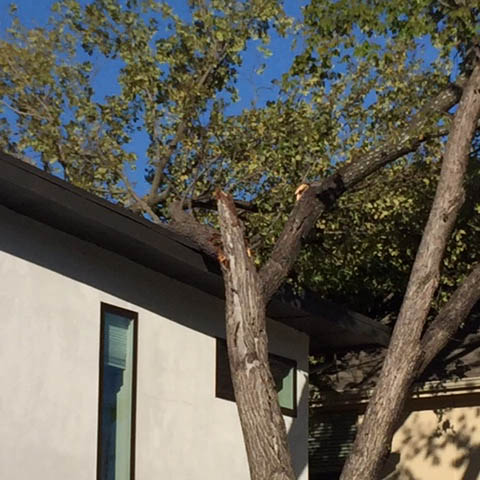Last Thursday afternoon (Oct. 2, 2014) a large and powerful storm swept through the Dallas metro area. Straight-line winds up to reported gusts of 90-mph did considerable damage around the area, and dealt a heavy blow to the power lines and trees all across the area. My home was without power for over 2 days, and 4 days later some Dallas residents are still without power.
So as time passed, we did what many people were doing – wait it out, find places to charge our cell phones, and toss every perishable food item in the refrigerator. And I hate wasting money like that when good food spoils. Come to think of it, this is the second time in two years we’ve had to clean out the refrigerator in this manner. A year ago the power line behind our house blew up (literally, the Oncor workers showed me the fragmented wire remnant left after it blew) and we were without power for long enough. So these events got me thinking, what’s a homeowner to do to prevent the loss of power?
First let me interject that any work related to electrical power can be inherently dangerous if done wrong or if proper safety precautions are not followed. Hire professionals where needed so you don’t get in over your head.
One method is to prevent power loss in the first place. Keep trees trimmed away from power lines – a 70- or 90-mph wind can deal a serious blow to tree limbs of all sizes, and even medium-weight limbs coming down on power lines can cause an outage. If you’re planting new landscaping, be mindful of how tall things will be in 10 or 20 years, so you don’t have to severely prune a prized tree.


I snapped these two photos (above) just after the storm. While these trees didn’t suffer much damage or cause power lines to fall, you can clearly see the trees are very close to this house being built. One of the trees (second photo) is already touching the eave of the house. Down the road, every time the wind blows this tree will further damage the eave. In my opinion there were two options available while this house (not designed by Fifth Dimension Design) was being designed:
1) Design the home away from the trees with good clearance, or 2) remove the trees. Now that the house is framed up and roofed, the only viable solution is to remove the trees and that takes away from the value of this nicely wooded lot. I’d hate to see the trees go, but I feel bad for the eventual buyer for the lifetime of issues these trees will cause.
How can you keep the power on even when there is a black-out or storm damage causes power outages? Get a back-up system, and these usually mean one of three things.
1) If you have the means to have solar panels and a battery grid to store electricity in, you can sustain power in your home in the event of a utility outage. Installing these systems is complicated and unfortunately pricey. Too pricey for some homeowners, me included. But your utility company may have rebates that can offset some costs, so check around.
2) Purchase a back-up generator. These are usually small gas- or diesel-powered generators that provide enough power for getting you through an outage. This means most of your home will be without power, but string a few extension cords around and you can run your refrigerator, a few lamps and fans, and maybe the TV set depending on what is important to you. Generators like these can be had for a few hundred dollars and up depending on size. Follow all manufacturer directions for use, and don’t place them indoors when you use them (this almost goes without saying but carbon monoxide poisoning is serious).
3) A more permanent option is to have a larger permanent generator installed. Several companies make them so they shouldn’t be hard to find, and you can size the generator to power your entire house or select electrical circuits. These generators sit beside your home and often run off of natural gas or propane. They automatically start and provide electricity when your house suffers a power outage. I believe regulations dictate that you also have a disconnect or transfer switch installed so electricity generated cannot go back up the utility company’s wires and endanger the workers who will be fixing the damage.
I ran one of the manufacturer’s online generator selection/sizing tools for my own home (2,000 sf, one central AC unit, and I wanted whole-house power rather than select circuits) and the tool estimated the recommended generator was in the $4,000 – $4,500 cost range, not including transfer switch, wiring, or installation. This option is probably great for new homes as you can plan for where to put the generator and have the equipment installed with little disruption.
Hope this helps keep the lights on. Have any other suggestions? Leave us a comment!
____________________________
This post was originally written before re-branding as Eckxstudio for Modern Architecture at the end of 2017.
At Eckxstudio for Modern Architecture, we design unique and stunning projects, individually crafted for our clients’ lives. We’re passionate about listening to your needs, wants and desires as inspiration to design the dream home you’ll never want to leave.







Leave A Comment